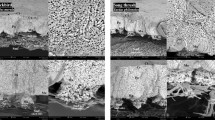Abstract
INVESTIGATION of avian medullary bone in this laboratory led to the observation of a substance therein which gave a very strong positive reaction with the periodic acid–Schiff technique. In some instances this took the form of branching homogeneous strands or fibrils of irregular thickness distributed in a less-strong periodic acid–Schiff-positive matrix; in other instances it was more dispersed and less distinctly fibrillar. Variation in the amount of this substance was also noted in different stages of the egg-laying cycle and, as a loss of chondroitin sulphate from the cartilage is known to precedo endochondral bone formation, an attempt was made to determine the nature of the periodic acid–Schiff-positive substance in avian bone and to correlate the variations in appearance and amount with the alternate absorption and deposition known to occur in this bone during the egg-laying cycle1.
This is a preview of subscription content, access via your institution
Access options
Subscribe to this journal
Receive 51 print issues and online access
$199.00 per year
only $3.90 per issue
Buy this article
- Purchase on Springer Link
- Instant access to full article PDF
Prices may be subject to local taxes which are calculated during checkout
Similar content being viewed by others
References
Bloom, M. A., Domm, L. Y., Nalbandoy, A. Y., and Bloom, W., Amer. J. Anat., 102, 411 (1958).
Hotchkiss, R. D., Stain. Tech., 23, 99 (1948).
McManus, J. F. A., Stain. Tech., 23, 99 (1948).
Lillie, R. D., Histopathologic Technic and Practical Histochemistry, 291 (The Blakiston Co., Inc., New York and Toronto, 1954).
Lillie, R. D., Histopathologic Technic and Practical Histochemistry, 139 (The Blakiston, Co., Inc., New York and Toronto, 1954).
Gersh, I., Arch. Path., 47, 99 (1949).
Heath, I. D., Nature, 191, 1370 (1961).
Takeuchi, J., Stain. Tech., 37, No. 2 (1962).
Gomori, G., Microscopic Histochemistry, 73 (Univ. Chicago Press).
Kramer, H., and Windrum, G. M., J. Histochem. and Cytochem., 3, 227 (1955).
Puchtler, H., and LeBlond, C. P., Amer. J. Anat., 102, 1 (1958).
Mowry, R. W., J. Histochem. and Cytochem. (Proc.), 4, 407 (1956).
Weber, J., Acta Anat. Supp., 31 A.D., 33 (1958).
Dempsey, E. W., Bunting, H., Singer, M., and Wislocki, G. B., Anat. Rec., 98, 417 (1947).
Harada, K., Stain. Tech., 31, 71 (1956).
Meyer, K., and Rapport, M. M., Adv. Enzymol., 13, 199 (1952).
Spicer, S. S., Swarm, R. L., and Burtner, H. J., Lab. Invest., 10, 256 (1961).
Irving, J. T., Clin. Orthopaedics, 17, 92 (1960).
Author information
Authors and Affiliations
Rights and permissions
About this article
Cite this article
CONKIE, D. Periodic Acid–Schiff-positive Component of the Medullary Bone of the Laying Domestic Fowl. Nature 197, 808–809 (1963). https://doi.org/10.1038/197808a0
Issue Date:
DOI: https://doi.org/10.1038/197808a0
Comments
By submitting a comment you agree to abide by our Terms and Community Guidelines. If you find something abusive or that does not comply with our terms or guidelines please flag it as inappropriate.



